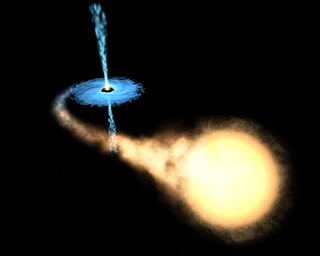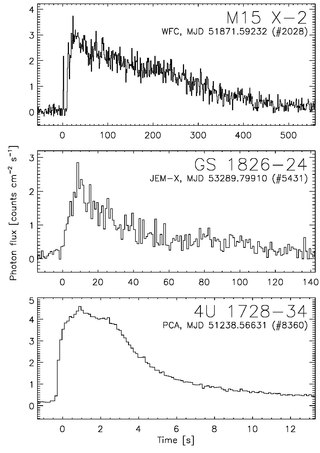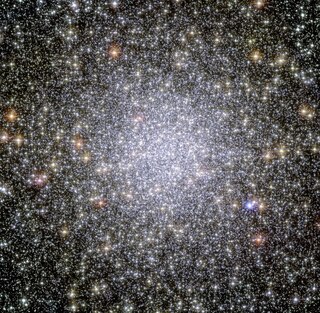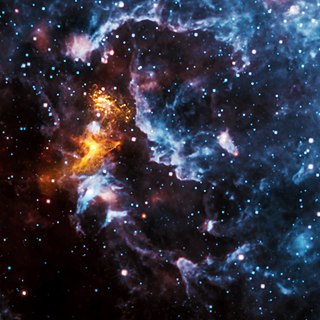Related Research Articles

A neutron star is the collapsed core of a massive supergiant star, which had a total mass of between 10 and 25 solar masses, possibly more if the star was especially metal-rich. Except for black holes and some hypothetical objects, neutron stars are the smallest and densest currently known class of stellar objects. Neutron stars have a radius on the order of 10 kilometres (6 mi) and a mass of about 1.4 solar masses. They result from the supernova explosion of a massive star, combined with gravitational collapse, that compresses the core past white dwarf star density to that of atomic nuclei.
Timeline of neutron stars, pulsars, supernovae, and white dwarfs

X-ray binaries are a class of binary stars that are luminous in X-rays. The X-rays are produced by matter falling from one component, called the donor, to the other component, called the accretor, which is very compact: a neutron star or black hole. The infalling matter releases gravitational potential energy, up to several tenths of its rest mass, as X-rays. The lifetime and the mass-transfer rate in an X-ray binary depends on the evolutionary status of the donor star, the mass ratio between the stellar components, and their orbital separation.

X-ray bursters are one class of X-ray binary stars exhibiting X-ray bursts, periodic and rapid increases in luminosity that peak in the X-ray region of the electromagnetic spectrum. These astrophysical systems are composed of an accreting neutron star and a main sequence companion 'donor' star. There are two types of X-ray bursts, designated I and II. Type I bursts are caused by thermonuclear runaway, while type II arise from the release of gravitational (potential) energy liberated through accretion. For type I (thermonuclear) bursts, the mass transferred from the donor star accumulates on the surface of the neutron star until it ignites and fuses in a burst, producing X-rays. The behavior of X-ray bursters is similar to the behavior of recurrent novae. In that case the compact object is a white dwarf that accretes hydrogen that finally undergoes explosive burning.
Be/X-ray binaries (BeXRBs) are a class of high-mass X-ray binaries that consist of a Be star and a neutron star. The neutron star is usually in a wide highly elliptical orbit around the Be star. The Be stellar wind forms a disk confined to a plane often different from the orbital plane of the neutron star. When the neutron star passes through the Be disk, it accretes a large mass of gas in a short time. As the gas falls onto the neutron star, a bright flare in hard X-rays is seen.
Soft X-ray transients (SXTs), also known as X-ray novae and black hole X-ray transients, are composed of a compact object and some type of "normal", low-mass star. These objects show dramatic changes in their X-ray emission, probably produced by variable transfer of mass from the normal star to the compact object, a process called accretion. In effect the compact object "gobbles up" the normal star, and the X-ray emission can provide the best view of how this process occurs. The "soft" name arises because in many cases there is strong soft X-ray emission from an accretion disk close to the compact object, although there are exceptions which are quite hard.
X-ray pulsars or accretion-powered pulsars are a class of astronomical objects that are X-ray sources displaying strict periodic variations in X-ray intensity. The X-ray periods range from as little as a fraction of a second to as much as several minutes.

47 Tucanae, or 47 Tuc is a globular cluster located in the constellation Tucana. It is about 4.45 ± 0.01 kpc (15,000 ± 33 ly) away from Earth, and 120 light years in diameter. 47 Tuc can be seen with the naked eye, with an apparent magnitude of 4.1. It appears about 44 arcminutes across including its far outreaches. Due to its far southern location, 18° from the south celestial pole, it was not catalogued by European astronomers until the 1750s, when the cluster was first identified by Nicolas-Louis de Lacaille from South Africa.

A pulsar is a highly magnetized rotating neutron star that emits beams of electromagnetic radiation out of its magnetic poles. This radiation can be observed only when a beam of emission is pointing toward Earth, and is responsible for the pulsed appearance of emission. Neutron stars are very dense and have short, regular rotational periods. This produces a very precise interval between pulses that ranges from milliseconds to seconds for an individual pulsar. Pulsars are one of the candidates for the source of ultra-high-energy cosmic rays.

A millisecond pulsar (MSP) is a pulsar with a rotational period less than about 10 milliseconds. Millisecond pulsars have been detected in radio, X-ray, and gamma ray portions of the electromagnetic spectrum. The leading theory for the origin of millisecond pulsars is that they are old, rapidly rotating neutron stars that have been spun up or "recycled" through accretion of matter from a companion star in a close binary system. For this reason, millisecond pulsars are sometimes called recycled pulsars.

A transient X-ray source first discovered in 1996 by the Italian-Dutch BeppoSAX satellite, SAX J1808.4−3658 revealed X-ray pulsations at the 401 Hz neutron star spin frequency when it was observed during a subsequent outburst in 1998 by NASA's RXTE satellite. The neutron star is orbited by a brown dwarf binary companion with a likely mass of 0.05 solar masses, every 2.01 hours. X-ray burst oscillations and quasi-periodic oscillations in addition to coherent X-ray pulsations have been seen from SAX J1808.4-3658, making it a Rosetta stone for interpretation of the timing behavior of low-mass X-ray binaries.

Walter Hendrik Gustav Lewin is a Dutch astrophysicist and retired professor of physics at the Massachusetts Institute of Technology. Lewin earned his doctorate in nuclear physics in 1965 at the Delft University of Technology and was a member of MIT's physics faculty for 43 years beginning in 1966 until his retirement in 2009.
The Bruno Rossi Prize is awarded annually by the High Energy Astrophysics division of the American Astronomical Society "for a significant contribution to High Energy Astrophysics, with particular emphasis on recent, original work". Named after astrophysicist Bruno Rossi, the prize is awarded with a certificate and a gift of USD $500, and was first awarded in 1985 to William R. Forman and Christine Jones Forman "for pioneering work in the study of X-ray emission from early type galaxies". It has been awarded 32 times. In 2010, the prize was awarded to William B. Atwood, Peter Michelson and the Fermi Gamma-ray Space Telescope team "for enabling, through the development of the Large Area Telescope, new insights into neutron stars, supernova remnants, cosmic rays, binary systems, active galactic nuclei, and gamma-ray bursts". In 2013, the prize was awarded to Roger W. Romani of Leland Stanford Junior University and Alice Harding of Goddard Space Flight Center for their work in developing the theoretical framework underpinning the many exciting pulsar results from Fermi Gamma-ray Space Telescope.

An ultraluminous X-ray source (ULX) is an astronomical source of X-rays that is less luminous than an active galactic nucleus but is more consistently luminous than any known stellar process (over 1039 erg/s, or 1032 watts), assuming that it radiates isotropically (the same in all directions). Typically there is about one ULX per galaxy in galaxies which host them, but some galaxies contain many. The Milky Way has not been shown to contain a ULX, although SS 433 may be a possible source. The main interest in ULXs stems from their luminosity exceeding the Eddington luminosity of neutron stars and even stellar black holes. It is not known what powers ULXs; models include beamed emission of stellar mass objects, accreting intermediate-mass black holes, and super-Eddington emission.
In X-ray astronomy, quasi-periodic oscillation (QPO) is the manner in which the X-ray light from an astronomical object flickers about certain frequencies. In these situations, the X-rays are emitted near the inner edge of an accretion disk in which gas swirls onto a compact object such as a white dwarf, neutron star, or black hole.

Vela X-1 is a pulsing, eclipsing high-mass X-ray binary (HMXB) system, associated with the Uhuru source 4U 0900-40 and the supergiant star HD 77581. The X-ray emission of the neutron star is caused by the capture and accretion of matter from the stellar wind of the supergiant companion. Vela X-1 is the prototypical detached HMXB.
XTE J1739−285 is a neutron star, in the constellation Ophiuchus, situated approximately 39,000 light-years from Earth. It was first observed on 19 October 1999 by NASA's Rossi X-ray Timing Explorer satellite.

PSR B1937+21 is a pulsar located in the constellation Vulpecula a few degrees in the sky away from the first discovered pulsar, PSR B1919+21. The name PSR B1937+21 is derived from the word "pulsar" and the declination and right ascension at which it is located, with the "B" indicating that the coordinates are for the 1950.0 epoch. PSR B1937+21 was discovered in 1982 by Don Backer, Shri Kulkarni, Carl Heiles, Michael Davis, and Miller Goss.

Michiel Baldur Maximiliaan van der Klis is a Dutch astronomer best known for his work on extreme 'pairings' of stars called X-ray binaries, more particularly his explanation of the occurrence of quasi-periodic oscillations (QPOs) in these systems and his co-discovery of the first millisecond X-ray pulsar. In the 1980s he gained worldwide fame with his investigation of QPOs. His revolutionary discoveries have had an enormous impact in his field of research; in effect, they have made it what it is today. Van der Klis pioneered special mathematical analysis techniques that are now regarded as the “gold standard” within his discipline.

Luciano Rezzolla is an Italian professor of relativistic astrophysics and numerical relativity at the Goethe University Frankfurt. His main field of study is the physics and astrophysics of compact objects such as black holes and neutron stars. It was announced in 2019 that he had been appointed honorary Andrews Professor of Astronomy at Trinity College Dublin (TCD).
References
- 1 2 "Rudy Wijnands, professor of Observational High-Energy Astrophysics". University of Amsterdam. 18 September 2017. Retrieved 2 December 2018.
- ↑ Wijnands, Rudy; van der Klis, Michiel (1998). "A millisecond pulsar in an X-ray binary system". Nature . 394 (6691): 344–346. Bibcode:1998Natur.394..344W. doi:10.1038/28557. S2CID 4428048.
- ↑ "HEAD AAS Rossi Prize Winners". American Astronomical Society . Retrieved 2 December 2018.